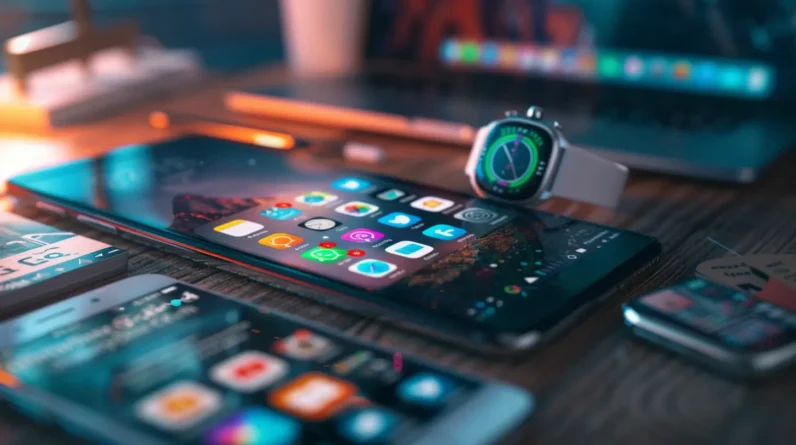
When we compare smartwatches and phones, we find that each has its strengths. Smartwatches excel in portability and fitness tracking, making them perfect for on-the-go use. Phones, however, shine in communication and offer a broader range of features. We’ll need to consider factors like battery life, screen size, app ecosystems, and value for money to see which device suits our needs best. Let’s explore these aspects further to make an informed choice.
Portability and Wearability
When it comes to portability and wearability, smartwatches have a clear advantage. We can easily strap them to our wrists, allowing us to access features without even taking our phones out of our pockets. This convenience is unparalleled, especially during workouts or when our hands are full. Smartphones, while portable, still require us to carry them in our hands, pockets, or bags. The larger size of smartphones can make them cumbersome during physical activities. With a smartwatch, we have the freedom to move without restraint, enjoying the benefits of technology without sacrificing comfort or mobility.
Communication Capabilities
While smartwatches offer a level of convenience in terms of portability, their communication capabilities are somewhat limited compared to smartphones. We can make calls, send texts, and even use some apps on our wrist, but the experience is not as robust as on a phone. Let’s break it down:
| Feature | Smartwatch | Smartphone |
|---|---|---|
| Voice Calls | Limited, speakerphone only | Extensive, handset or speakerphone |
| Texting | Short replies only | Full keyboard, easy typing |
| Notifications only | Compose, reply, attachments | |
| Social Media | Limited apps, notifications | Full app experience |
| Video Calling | Not feasible | High-quality video calls |
As we can see, smartwatches are useful for quick communication on the go, but smartphones provide a more comprehensive and versatile experience.
Health and Fitness Tracking
Smartwatches take the lead when it comes to health and fitness tracking. They’re designed to monitor our heart rate, count our steps, and track our workouts. With built-in GPS, we can even map our runs or cycles without needing to carry our phones. Smartwatches also offer sleep tracking, helping us understand our sleep patterns and improve our rest. While some phones have fitness apps, they can’t match the convenience and accuracy of a device that’s always on our wrist. For those serious about their health and fitness goals, a smartwatch is a valuable tool.
Battery Life and Charging
Although smartwatches have many advantages, their battery life often falls short compared to phones. We’ve all experienced that dreaded moment when our watch dies midday, leaving us disconnected. Most smartwatches require daily charging, while phones can usually go a full day or two between charges. However, smartwatch batteries are improving, and some models now last two to three days. Plus, many watches have quick-charging capabilities, so you can top off the battery during your morning routine. Still, if you frequently forget to charge your devices, a phone’s longer battery life may suit your needs better.
Screen Size and Usability
One of the most noticeable differences between smartwatches and phones is their screen size. Smartwatches have significantly smaller screens, which can impact usability. Let’s compare:
| Feature | Smartwatch | Phone |
|---|---|---|
| Screen Size | 1.5-2 inches | 6-7 inches |
| Readability | Lower | Higher |
| Typing | Difficult | Easier |
| Video | Not ideal | Great |
| Maps | Challenging | Better |
As we can see, the phone’s larger screen offers better readability, easier typing, and a superior experience for videos and maps. However, the smartwatch’s compact size allows for quick, glanceable information access, which can be useful on the go.
App Ecosystem and Customization
While both smartwatches and phones offer access to a variety of apps, the app ecosystem and customization options differ between the two devices. Smartphones generally have a more extensive app selection, allowing for greater personalization and functionality. We can find apps for nearly any purpose on our phones, from productivity to entertainment. Smartwatches, on the other hand, tend to have a more limited app selection, focusing primarily on fitness tracking, notifications, and basic communication. However, many smartwatches allow for customizable watch faces and complications, enabling quick access to our most-used features and adding a personal touch to our wrist-worn companions.
Price and Value for Money
When it comes to price and value for money, there are notable differences between smartwatches and phones. Generally, phones tend to be more expensive than smartwatches, given their broader range of features and capabilities. However, we must consider the value each device brings to our lives. Smartwatches offer convenience and quick access to essential functions, making them valuable despite their lower price. Phones, with their extensive app ecosystems and customization options, provide more versatility and potential for productivity. Ultimately, the better value depends on what we prioritize: the convenience of a smartwatch or the multifunctionality of a phone.
Conclusion
In the end, the choice between a smartwatch and a phone depends on your priorities. If portability and fitness tracking are key, a smartwatch might be your best bet. But if communication and a larger screen are essential, stick with your phone. As the saying goes, “Different strokes for different folks.” Carefully weigh the trade-offs to find the device that best fits your lifestyle and needs.







